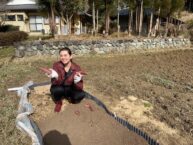My CIP was volunteering at Saint Mary’s Church’s Children soup kitchen with my good friend Alex. We would head over to the Church every Monday to help out for about two hours. We were originally tasked to help out in the kitchen by cutting ingredients and washing dishes. By the second time we went, we were instead redirected to play with and run around with the children. The actual period for serving food was 7 pm – 8 pm, but we came at about 6 pm, when kids started coming to the church. Every week we would end up playing with the children for about an hour, then help set up tables and eat the delicious food together!
Instead of volunteering to help serve food to children, it really felt like I was volunteering to keep the kids entertained, which was really fun to do. When the kids played with us, they would speak Japanese too quickly and often with a Kansai accent. I wouldn’t understand them about half the time. One particular time, I asked one child to repeat what they said and they said it even faster to play with me. Being able to interact and communicate with the children was one of the best parts of my CIP and it made it extremely fun and enjoyable. With the energetic kids running around and playing with each other and the pastor and parents yelling at the kids to stop, it really made me think that young kids really do act the same no matter where you go.One big thing that I noticed when observing the children was that they would actually clean up by themselves after eating and would move back the table they ate on by themselves. It surprised me because that rarely happens in America. I feel that most children in America probably wouldn’t clean up unless their parents yelled at them to do so. Another cool thing that I was able to observe is the different kinds of games that kids play in Japan and how some games are basically the same in America, but named differently. For example, “onigokko” is basically just “tag”. Another cool thing that I was able to observe is the different kinds of games that kids play in Japan and how some games are basically the same in America, but named differently. For example, “onigokko” is basically just “tag”. Another cool thing that I was able to observe is the different kinds of games that kids play in Japan and how some games are basically the same in America, but named differently. For example, “onigokko” is basically just “tag”.
Not only was interacting with the children fun, but it was also fun to talk with the other volunteers and the parents. I was able to feel how nice and caring everyone was. Learning about the backgrounds of each person was also very interesting! I was also able to learn new vocabulary and random knowledge from them!
I feel that it was such an honor to be able to have been part of the church’s community, filled with caring and generous people. I wish I was able to help out more and were able to connect more with the members of the community. I especially wanted to connect more with the pastor of the church. During my last meeting with him before coming back to America, he brought us out to eat dinner and we talked a lot about religious things. But while he was driving me back home, I found out that he was also a big anime fan and I want to talk more about anime with him! It is a shame that my CIP activity was cut short. When I visit Japan again someday I will for sure make a stop at the church and say hi!

